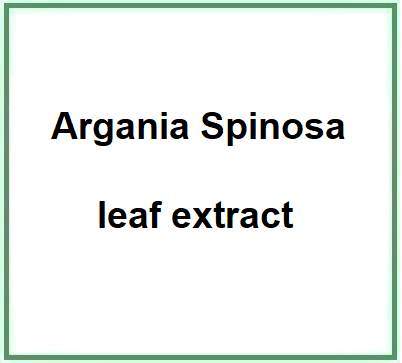Argania spinosa leaf extract is the dried extract of the leaves of the plant of the same name. There are many different extraction methods: maceration, maceration with movement, ultrasonic extraction (from 20°C to 85°C), ultrasonic extraction, reduced pressure extraction, percolation, diacolation, continuous reflux solid-liquid extraction, which is performed in a Soxhlet extractor. If extraction is by mechanical crushing, a mortar is generally used. The preferred method of extraction may use water, polyethylene glycols, ethyl acetate, dichloromethane, trichloromethane and their mixtures, methanol, ethanol, acetone, propylene glycols.
Argania spinosa L.Skeels, is a large tree native to south-western Morocco, belonging to the Sapotaceae family and the genus Argania. It is usually about 8 metres high, but can reach, under favourable soil and climate conditions, 20 metres with a trunk diameter of 1 metre. The fruits are oval, the size of a walnut, green or bright yellow and are used to feed cattle, sheep and goats. In 2014, UNESCO declared this tree to be on the Representative List of the Intangible Cultural Heritage of Humanity. Not only the leaves are used for extracts, but also the root, stem, flower and fruit.
What it is used for and where
Medical
The phytochemical composition includes (1)
- tocopherols (γ-tocopherol, δ-tocopherol, α-tocopherol)
- sterols (schottenol 46%, cholesterol 0.32%, campesterol 0.31%)
- monounsaturated fatty acids 45% (oleic acid, gadoleic acid)
- polyunsaturated fatty acids 31% (linoleic acid, linolenic acid)
- saturated fatty acids 20% (palmitic acid, stearic acid, arachidic acid, myristic acid)
- polyphenols (ferulic acid, syringic acid, p-hydroxybenzoic acid, vanillic acid)
- triterpenoids
these components and the saponins present both in the plant and in the oil, with their antioxidant activity have been shown to exert anti-hyperglycaemic antidiabetic, antihypertensive activity. Polyphenols that have demonstrated antidiabetic activity: caffeic acid, gallic acid, quercetin, epicatechin
Cosmetics
Skin conditioning agent. An ingredient that is the mainstay of topical skin treatment by restoring, increasing or improving skin tolerance to external factors, including melanocyte tolerance. The most important function of the conditioning agent is to prevent skin dehydration, but the subject is rather complex and involves emollients and humectants.
Water-soluble antioxidant. It is used in cosmetic products for its nourishing, moisturising, skin-protective and hair-protective properties conferred by saponins, polyphenols and tocopherols, which also have activities to stretch and repair the stratum corneum. Also used as a bleaching agent due to its ability to promote melanogenesis, it can be used in cosmetic products as a therapy against hypopigmentation disorders (2).
CAS 223747-87-3
The most relevant studies and their abstracts have been selected to expand on this topic:
Argania spinosa studies
References_____________________________________________________________________
(1) Kamal R, Kharbach M, Heyden YV, Yu H, Bouklouze A, Cherrah Y, Alaoui K. In Vitro & In Vivo Anti-Hyperglycemic Potential of Saponins Cake and Argan Oil from Argania spinosa. Foods. 2021 May 13;10(5):1078. doi: 10.3390/foods10051078.
(2) Makbal R, Villareal MO, Gadhi C, Hafidi A, Isoda H. Argania Spinosa Fruit Shell Extract-Induced Melanogenesis via cAMP Signaling Pathway Activation. Int J Mol Sci. 2020 Apr 6;21(7):2539. doi: 10.3390/ijms21072539.
![]() Argania spinosa leaf extract
Argania spinosa leaf extract 

